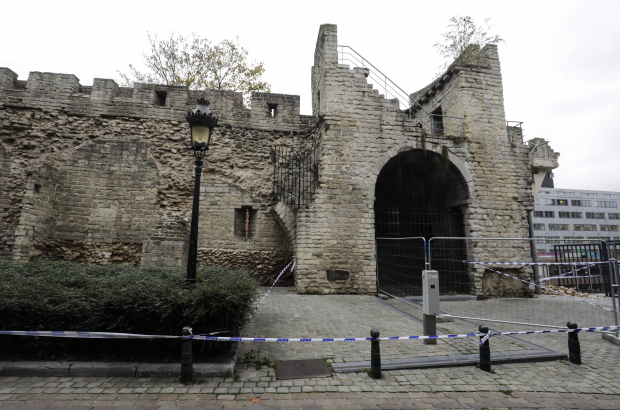- Daily & Weekly newsletters
- Buy & download The Bulletin
- Comment on our articles
Medieval wall no closer to being reconstructed two years after collapse
In the early morning of 28 November 2018, a wall dating from the 13th century collapsed in the city centre of Brussels, behind the Rue des Alexiens. The collapsed wall, some 20m long and several metres high, left debris across the courtyard of the Sint-Joris school, which backs on to the medieval structure. Fortunately, the incident happened over the weekend, when the school was closed and no one was injured.
However, the wall is not the only thing to be damaged. Brussels' heritage has been affected too. Not only has the city seen a monument of its past collapse but the proposed rebuilding of the wall and the complications which have delayed its repair for two years has raised questions over ownership and responsibility.
The case is a complex one. First of all, the wall is a listed monument. Its collapse is therefore a heritage issue, meaning the owner of the wall will have to repair it. But if the reason for the collapse is determined to be the fault of another party, then they become responsible.
The trouble is that the exact ownership of the wall has not yet been determined. There is no agreement between the Sint-Joris school board on one side of the wall and the owner of an apartment block on the other. The medieval wall acted purely as a partition between the two separate pieces of land.
Secondly, the cause of this collapse is unknown. Work was taking place in the schoolyard at the time of the incident, but did the company responsible for this work cause the fall? Or did various other factors over the centuries combine to contribute to the collapse? Again, it is a game-changer. Because if an owner is determined and that owner coordinates and pays for the reconstruction work, once this work is completed, that owner can turn against and demand compensation from the party who is deemed responsible for the collapse. The stakes are therefore high, with legal implications, which explains why none of the parties involved are yet to make any formal claims.
It remains to be seen how the wall will be rebuilt. This is another matter of contention. Heritage Brussels has been consulted on the matter and is following the case closely.
"We can at least reassure all parties, there is no risk of further collapse at the location," says Ann Degraeve, the archaeologist in charge of the file at Heritage Brussels. "A few months after the collapse, at the request of the Sint-Joris school, the VGC (Flemish Community Commission in Brussels, in charge of the Dutch-speaking schools in the Region) intervened. Its services have built an embankment to stabilise the ground. This embankment actually contains the materials of the original wall. And they are protected by several layers so that they do not deteriorate."
As for the tower and the other part of this surviving medieval structure, they are owned by the City of Brussels. And it is the city's services that have been monitoring the stability of the site regularly for the past two years.
So, will the collapsed wall be rebuilt in the same way? "On the face of it, we can say no," says Ann Degraeve. "The concern is that this wall was a kind of patchwork that evolved over time. There are many limestone stones laid in the 13th century. But since then, the inhabitants have also added bricks over the years. Original little viewpoints had been enlarged to make real windows. All this is known because we had analysed this wall in detail before it collapsed."
So, what form will the reconstruction take? "It's still to be determined,” Degraeve adds. “But what is certain is that we have to rebuild; for stability, but above all for heritage. This first part of the City of Brussels from the 13th century is an invaluable remnant of our past. It is important that we keep this wall which is part of one of the last stretches still visible and preserved. So we are looking at ways to carry out the most faithful reconstruction in terms of the place and its history. Perhaps this means only using the techniques and materials of the 13th century. But this still has to be decided."
The Brussels Capital Region has been mediating on this issue for several months now and has already organised several meetings between the parties involved and with the City of Brussels (since it owns the tower and the neighbouring wall). The file has even been entrusted to the region's master architect, so that he can give his opinion on reconstruction and can possibly coordinate proceedings once a way forward is found. There have also been discussions on organising a possible architectural competition to find and select the best way to rebuild the wall.
What is certain is that it will take more time. "It may be several years before a reconstruction is carried out,” concludes Ann Degraeve. “But I'm positive we will recover this part of our Brussels' heritage."



















